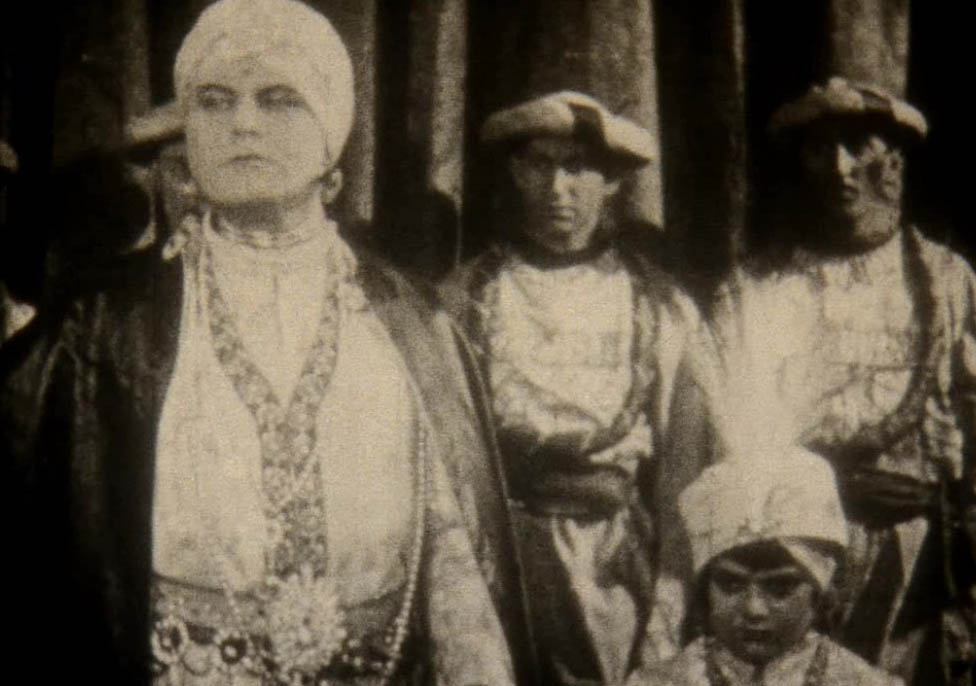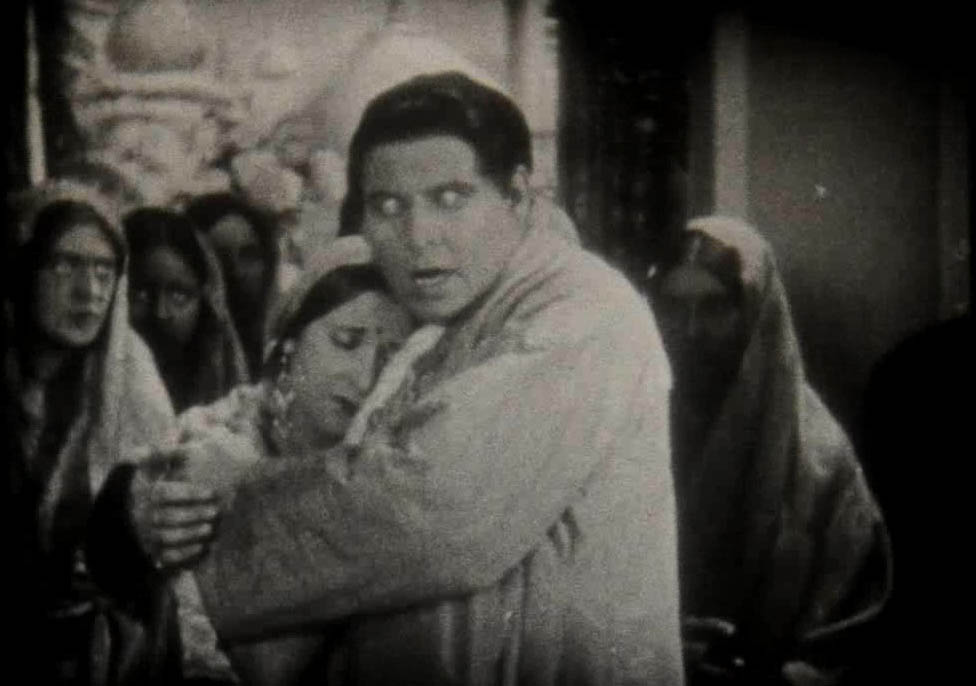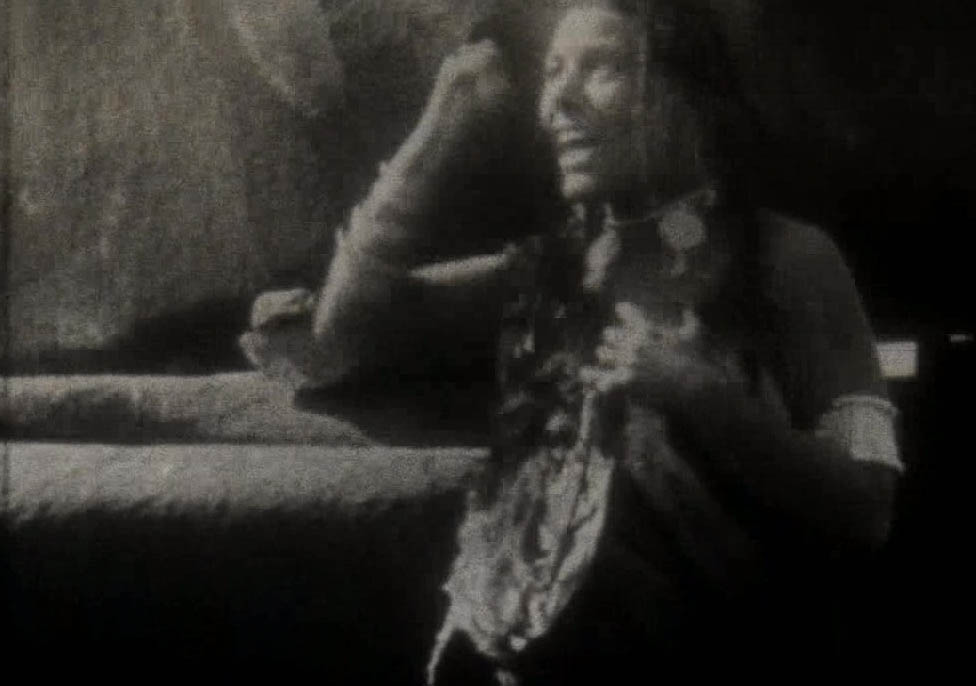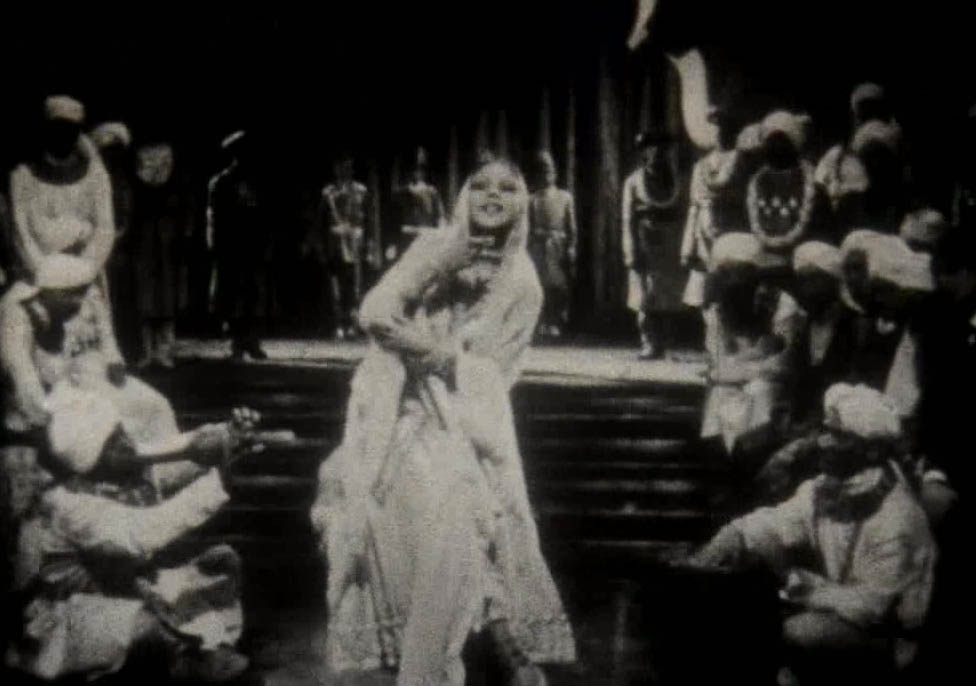An uprising, a double kidnapping and one thwarted execution by tiger… And that’s just the first half. This film was partially shot on location in India and was based on a novel by Indian author Jerbanu Kothawala.
Home Media Availability: Watch it on YouTube.
A Tiger’s Lunch
Emerald of the East was released on 35mm film in 1929 and was subsequently made available on the home viewing market. This review is based on a 9.5mm print from the collection of Christopher Bird and he has generously made it available on YouTube. Film accompanist David L. Gill has been equally generous and has created a suitable and authentic score for the film based on vintage silent film music. A huge thanks to both Chris and David for making this review possible.
Like most 9.5mm releases, Emerald of the East was condensed down. The version we will be seeing runs just under twenty minutes. The British Film Institute holds a copy of the complete six-reel release on 35mm.
Emerald of the East was shot partially on location in Gwalior and the filmmakers enjoyed the use of the army, cavalry and elephants, as well as the palace grounds and jewelry belonging to the royal family. However, the opening title card gives the location as Vijaypore (now Romanized as Bijeypur), a hundred miles and change away.
The film opens with the British-allied Maharajah (Jean de Kuharski) giving a lavish birthday party to his young heir. Meanwhile, Lt. Desmond Armstrong (Joshua Kean) is arriving back in India after two months in England. He intends to marry his beloved Evelyn (Gillian Dean) once he earns a promotion.
All is not well at the palace. The young prince and his attendant are hypnotized by one of the Maharajah’s enemies, the Chieftainess (Maria Forescu), and she escapes with the boy. The Maharajah sets off to rescue his son and runs into Armstrong, who he orders to aid in his search. Agents of the Chieftainess capture the hapless Armstrong immediately and take him to the village where the prince is also being held.
Fortunately for Armstrong, the Chieftainess has a beautiful daughter, Nellum (Mary Odette), the “emerald” of the title. She finds the captive soldier to be unspeakably gorgeous and resolves to rescue him and the prince. It’s a good thing, too, because Armstrong has been sentenced to being tied to “the Tree of Death” as tiger kibble. Nellum’s quick thinking saves the day and the prince insists that she be allowed to escape with them in order to protect her from retaliation.
Back at the palace, Armstrong gets to ride on the Maharajah’s elephant during a homecoming parade for the prince. And Nellum… is hired as Armstrong’s housekeeper. Hmm. His promotion secured, Armstrong is able to send for Evelyn but Nellum still adores him.
The Maharajah is alerted that the Chieftainess is about to lead an uprising, so he rides off to face her with Armstrong assisting. Nellum begs Armstrong to spare her mother and he agrees. Strikes me that the Maharajah should have brought along the person who knows the mountain terrain and is familiar with her mother’s plans but what do I know?
Will Armstrong win that promotion? Will Nellum’s bravery ever be recognized? See Emerald of the East to find out!
Obviously, when reviewing a condensation, it’s not fair to talk about plot holes and inconsistencies. That being said, I do think Emerald of the East benefitted from being cut down. Reviews of the full picture are not very encouraging but in its twenty minute form, it’s a zippy (albeit jingoistic) adventure film.
Whoever selected the footage for inclusion in the condensation clearly had an eye for keeping the more impressive Indian location scenes intact, as well as the action scenes, and ruthlessly slicing away just about anything else. There are parties, parades, shows of British military might and, of course, elephants.
In researching my review of Shiraz, I found the 1927-1928 Report of the Indian Cinematograph Committee, which expressed concern that non-British money—German, in this case— was being used to finance an Indian production. The committee expressed worry that Hollywood would come sniffing around and take over Indian film productions. I wonder if British International Pictures was responding directly to calls for more British money in Indian film. Emerald of the East was released just four months after Shiraz. (I should also note that the conclusion that the German funding of Shiraz was concerning was rigorously rebutted in the same report.)
The main roles were all played by European performers and, for what they are, they range from pretty good (Mary Odette is appealing as the underappreciated Nellum) to painful (director Jean de Kuharski bulges his eyes and chows down on scenery as the Maharajah).
The camera work is not resoundingly impressive but there are a few nice scenes. The hypnotism n’ kidnapping sequence is particularly fun in a pulpy way with double exposed eyes luring the young prince to his own capture.
I have not read Indian author Jerbanu Kothawala’s original story and cannot say for sure which story elements were hers and which were from the imaginations of screenwriters Lothar Knud Frederik and de Kuharski (German and Polish, respectively). However, I can say that most of the problems with the film can be traced directly back to the screenplay.
Armstrong just isn’t a very interesting protagonist. In fact, he’s as bland as porridge. He shows up in India because he was assigned there, has no particular opinions about the land or people and no motivation other than wanting to be useful and to marry his fiancée. He stumbles into trouble and has to wait to be rescued by Nellum.
Nellum has to betray her mother and her cause to rescue Armstrong and the prince, so she is already the more interesting character. Instead of being given more to do in the story, Nellum is rewarded by being hired as Armstrong’s housekeeper. Thanks? Armstrong gets his promotion despite Nellum and the Maharajah having done all the actual work.
(Spoiler) The conclusion of the rebellion is similarly odd. The Maharajah just approaches the Chieftainess and is like, “Can you not?” and the Chieftainess is like, “Oh, yeah, okay, I won’t.” And that’s that. They’re buddies for life. I mean, when someone goes as far as kidnapping their rival’s small child, the dispute has gone way beyond political posturing.
Of course, this may have something to do with the censorship of the time. For example, the Bombay Board of Film Censors listed as objectionable films that “are calculated or possibly intended to foment social unrest and discontent” as well as films that “are calculated to promote disaffection or resistance to Government or to promote a breach of law and order.”
And why couldn’t the Chieftainess meet a bloodier end? Well, number 25 on the censor board’s list of objectionable topics was “Executions.”
Emerald of the East was intended for British audiences but it was partially made under British authorities in India, so these considerations were likely on the minds of the filmmakers, especially since the film enjoyed the cooperation of the local government.
While Emerald of the East has definite issues—mainly its confusion as to who should be the protagonist—there are some stylish moments. It’s not a lost masterpiece or anything but I am very curious to see the complete film in order to find out if my suspicions are correct and the condensation was an improvement.
Whenever I see a silent film that’s a bit disappointing, I am still pleased because at least I know whether it is good or bad for myself. So much early film history is based on hearsay due to the tragically low survival rate of silent movies and I consider any extant film to be a cause for celebration.
The Music of Emerald of the East
A good score elevates a silent film and that is certainly the case here. David L. Gill was nice enough to share some background information on his selection process.
When I watched Emerald for the first time, I knew I needed a grand opening. I played around with some regal-sounding music and landed on a march by Mendelssohn which I found in a book of short arrangements for accompanying silent film.
In the same book, I found a wonderful piece of music for the dancing girl at the party. On screen, there is what I believe to be a pungi, a wind instrument from India which is used often in snake-charming. In the later scene where the son of the Maharajah is playing on the palace grounds, one of the members of the household plays a pungi again. Knowing that children love repetition and re-living fun experiences (I mean, the same is true of adults, right?), I decided I would use the same dancing-girl theme I’d used at the party.
Then there was the matter of the love themes. I decided to have one theme for Evelyn and one for Neelum. This isn’t because I think Lt. Armstrong is in any way in love with Neelum; instead, I hope it helps the audience to connect with Neelum’s love and experiences throughout the film.
Battle music is important in a film like this. It has to reflect what’s happening on screen without being overblown. I was overjoyed to have encountered this piece in a score that Hugo Riesenfeld compiled for Monsieur Beaucaire. The pause in the middle is perfect to draw attention to the action taking place in that moment.
The return of the victorious Maharajah with the defeated chieftainess posed an interesting problem. When I was first sent the film, the speed of the action was slightly slower than what you see now. I wanted to use another piece of music which was from M. Beaucaire but the feedback I received from Fritzi and Christopher was that the piece was too much like a funeral dirge. I reluctantly set it aside.
Upon receiving a new scan of the film at the speed you are watching it in this release and after the passing of some time so that I could look at the project more objectively, I realized that the music not only still fit the mood but that the tempo had increased such that it no longer felt like a dirge. Instead, it felt regal for the triumphant folks but perhaps just solemn enough for the chieftainess so that her experience wouldn’t be negated.
It’s a challenge to score a feature film which has been cut down to roughly 20 minutes. Some scenes scarcely begin before they’ve ended and good music takes time to develop. But I think what has resulted gives the audience a taste of what the original film would’ve been like and is true to the time-period of film scoring.
Cue sheet:
- At screening. Processional – Festival – March – Jubilation (Mendelssohn – Roberts) (FT26)
- D: Dancing Girl. Oriental Dancing Girls [excerpt] (Goldmark – Roberts) (FT27)
- D: Sea waters. A Motor Ride (Bidgood)
- T: After 2 months’ leave. After Sunset (Pryor) [Evelyn’s Theme]
- T: In the gardens of the MP. Oriental Dancing Girls [excerpt] (Goldmark – Roberts) (FT27)
- D: Son walks away from merry-go-round. Misterioso Infernale (Borch) (Schirmer Photoplay #35)
- D: Maharajah smoking. Diabolical Allegro (M. Bergunker) (Schirmer Photoplay #60)
- D: Riding to rescue. Passepied (Delibes)
- D: Troops disperse. Agitato (M. L. Lake) (Carl Fischer 30)
- T: Meanwhile the prince. Marcia Funebre – Breil No. 12 (J. C. Breil) [adapted]
- D: Lt. Armstrong appears, tied to tree. Love Theme (Brockton) (CF 31) [Neelum’s Theme]
- D: Tiger on the prowl. Agitato con moto (Gaston Borch) (Schirmer Photoplay #23)
- T: The return of the prince. Maestoso (M. L. Lake) (Carl Fischer 17)
- D: Fade-in to Lieutenant. After Sunset (Pryor)
- D: Lieutenant sees Neelum. Love Theme (Brockton) (Carl Fischer 31) [Neelum’s Theme]
- T: The next day. In Military Camp (Zamecnik)
- D: Neelum runs to horse. Allegro Agitato (Savino) (Schirmer #48)
- T: The warrior tribesmen. Robin Hood, cue #23 at Allegro
- D: The field of battle. M. Beaucaire, cue #54
- T: The friendship. M. Beaucaire, cue #2-b
- T: From the glamour of the east. After Sunset (Pryor) [Evelyn’s Theme]
- D: Railroad tracks. Red, Red Rose (M. B. #17, chorus)
Where can I see it?
Emerald of the East can be viewed on YouTube with David L. Gill’s score. Enjoy!
☙❦❧
Like what you’re reading? Please consider sponsoring me on Patreon. All patrons will get early previews of upcoming features, exclusive polls and other goodies.
Disclosure: Some links included in this post may be affiliate links to products sold by Amazon and as an Amazon Associate I earn from qualifying purchases.
















Very interesting review. Am enjoying reading your reviews and articles, especially those referencing India! I’d be interested to know whether you have written anything on silent film cameras used in filming, and projectors used for showing the film to audiences? If not, I wonder if you could point me to any links/sources for information on cameras and projectors? Thanks very much.
Lantern has some nice resources:
https://lantern.mediahist.org/
Thank you!